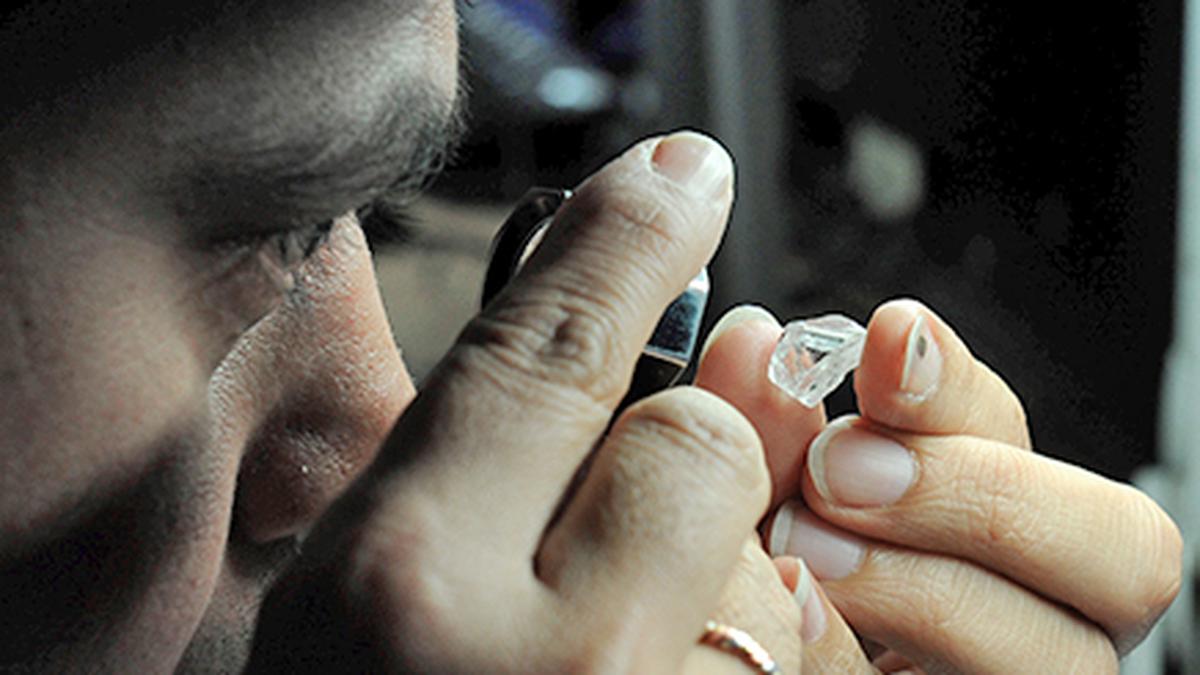
A worker in one of the oldest and largest diamond polishing units of Surat checking its dazzle. File
| Photo Credit: Vijay Soneji
Already grappling with job losses and a slowdown in orders, Gujarat’s diamond sector has been dealt another setback as the United States, its largest export destination, raised import duties to 25% with an additional tariff of 25% coming into effect from August 27, taking the total to 50%.
The hike, announced by U.S. President Donald Trump, has raised concerns among exporters who warn the rates are “unsustainable” for long-term trade, and are optimistic about the business. It comes at a time when industry is still struggling with the fallout of the Russia-Ukraine conflict and the growing presence of cheaper lab-grown diamonds in global markets.
Despite the grim statistics, some leaders are urging calm. “This is a temporary phase. The U.S. has no best viable alternative to India for loose and jewellery diamonds,” said Jagdish Khunt, president of the Surat Diamond Association. “Yes, tariffs are a blow, but it will eventually push prices up in the U.S., and buyers there will have to absorb the difference because sourcing from India remains unavoidable,” he told The Hindu.
Industry estimates show that the U.S. alone accounts for more than 30% of India’s gem and jewellery exports, making it the single-largest overseas buyer. In Gujarat, where nearly 90% of natural diamonds imported to India are cut and polished, trade bodies say more than one lakh workers have lost jobs since April this year.
In May, the Gujarat government rolled out a relief scheme aimed at helping diamond artisans and small units hit by a global slowdown. More than one lakh former workers from the sector have sought assistance under the programme, which offers ₹13,500 per child to support affected families.
“Nearly 90% of India’s supply is processed here. What other alternatives do they have? We have the best ‘ratnakalakars’ (diamond artisans) in the world, and a customer buying diamonds will never compromise on quality,” asks Mr. Khunt.
He compared the American affinity for diamonds to the Indian love for gold, noting that just as Indians continue to purchase gold despite soaring prices, U.S. consumers remain steadfast in their preference for diamonds. “No matter the circumstances, they pick diamonds over gold. We expect the market to steady ahead of Christmas and New Year, with fresh orders starting to flow in,” he said, adding that over 7.5 lakh artisans are working in 3,500 small and large units.
Data from the Gem and Jewellery Export Promotion Council (GJEPC), India’s apex body for the industry, shows that in the 2024–25 fiscal year, India shipped cut and polished diamonds worth $4.8 billion to the United States. The U.S. market thus accounted for over one-third of the country’s total diamond exports, which amounted to $13.2 billion for the year. According to GJEPC, India’s rough diamond imports fell sharply in 2024–25 to $9.52 billion, down from $14.26 billion in the previous fiscal.
Babu Vaghani, president of the Lab-Grown Diamonds Association, shared Mr. Khunt’s optimism, describing the current situation as a “short-term crisis.” “Whatever the challenges, we must keep going until Diwali. Even if it means trading on smaller margins, the work has to continue for the sake of the lakhs of people who depend on it for their livelihood,” he said.
Mr. Vaghani pointed out that more than half of the artisans outside Surat, particularly in Bhavnagar, Botad, Mehsana, and other districts, are women. “In rural areas, women play a major role in diamond polishing,” he added.
Published – August 15, 2025 08:04 am IST



